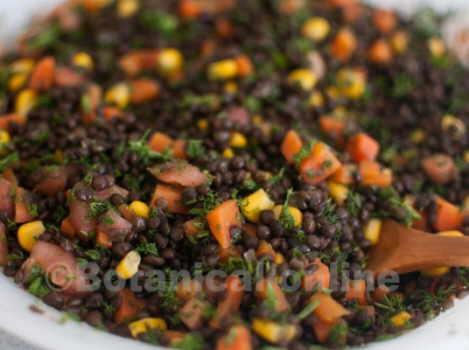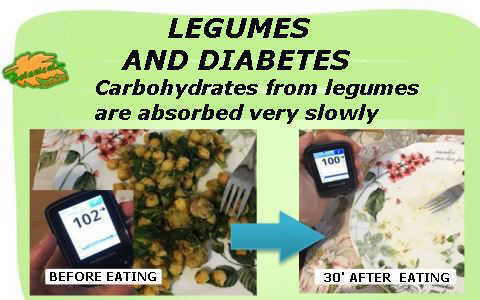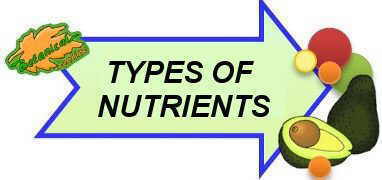Contents
- 1 Are legumes good for people with diabetes?
- 1.1 PROPERTIES OF LEGUMES FOR DIABETES
- 1.2 Is it advisable to eat legumes for diabetes?
- 1.3 Benefits of legumes for diabetes
- 1.4 Myths about legumes and diabetes
- 1.5 Do legumes have a lot of carbohydrates?
- 1.6 How much legumes amount is recommended for diabetes?
- 1.7 Will not be bad eating legumes every day ? Are legumes not indigestible? Gases?
Are legumes good for people with diabetes?
PROPERTIES OF LEGUMES FOR DIABETES
Is it advisable to eat legumes for diabetes?
Legumes are a group of highly recommended foods for diabetes, in fact, they are better tolerated than a dish of rice, potato or pasta. In addition to having slow-absorbing carbohydrates, they are very nutritious and beneficial for diabetes:
 Photo of lentil salad
Photo of lentil saladBenefits of legumes for diabetes
- They are very rich and constitute an excellent source of nutrition: they contain proteins, fiber, vitamins and minerals in a very good quantity
- They do not raise blood sugar or produce hyperglycemia, their carbohydrates are assimilated slowly and (they have a low glycemic index and a low glycemic load)
- They decrease blood sugar levels after meals. Being foods that need a long digestion in the stomach (by proteins and fiber), help the passage of food to the intestine is slower, and therefore, not so much sugar after eating.
- They are an equal or even more recommended option than whole grains,
- Far beyond the nutritional value of white rice and pasta
Myths about legumes and diabetes
There are many myths about legumes. There should be no doubt that these foods are very beneficial and totally recommended for diabetes, and that they can be consumed almost daily. However, myths still circulate about whether chickpeas, lentils or peas raise sugar … it is false!
It is very important, both for doctors, nutritionists and dietitians and people with diabetes, to know everything related to these foods and blood sugar:
- The carbohydrates of the legume are assimilated very slowly. According to official tables, lentils have a low glycemic index and a low glycemic load. That is, their carbohydrates are assimilated very slowly. It is a mistake to consider legumes as the equivalent of rice or pasta
- Legumes do not produce the same glycemic peaks as rice or pasta. The rise in blood sugar after meals (postprandial glycemia) of cereals and tubers is faster and higher than legumes.
- Legumes raise much less sugar than rice, potatoes or pasta. The carbohydrates of the legumes take about 60 minutes to assimilate and the peak of glycemia is lower.
- When you eat legumes with meat or a lot of oil (“cooked” or stews) it still takes more time to absorb carbohydrates, since fat and protein lengthen the time of digestion and slow down gastric emptying
- There is a risk of hypoglycemia if you take insulin and eat legumes, because these foods remain so long in the stomach that, even if you take fruit for dessert, it will take longer to increase your blood sugar. The “hypoglycemia of chickpeas” is very well known among diabetics. This risk is only high with insulin, not with other antidiabetic medications.

Two pictures: one before and another one 30 minutes after having finished eating chickpeas and a person’s blood glucose (without diabetes) in each case. You can see how blood sugar levels do not rise quickly after eating chickpeas. The postprandial peak of legumes occurs almost at 60 minutes and it is low, about 130-140 mg glucose / dL. Therefore, at the glycemic level you can not compare a chickpea dish with a rice dish.
Do legumes have a lot of carbohydrates?
It is said that it would not be convenient for people with diabetes to abuse chickpeas because their carbohydrate content is very high, but it is false.
In no case eating chickpeas, peas or any other legume can produce hyperglycemia, unless combined with very sugary foods, such as a chocolate dessert or similar (in which case, the person responsible for hyperglycemia would not be the legume). Even in these cases, the legume would decrease the glycemic peak of sugary foods.
The reason why the legume will never give hyperglycemia is because, in addition to carbohydrates, they also contain a lot of fiber, vegetable proteins and fat (the oil with which they are usually cooked), which delay the assimilation of carbohydrates. Therefore, whatrever legume we it, it will raise our sugar level in blood.
Quite the opposite: combining legume with cereal, potato or pasta decreases the blood glucose peak (decreases the glycemic index of these foods).
How much legumes amount is recommended for diabetes?
For all these reasons, it is very advisable that people with obesity, diabetes, cholesterol or problems with the metabolism of sugar, begin to introduce legumes in their diet.
Legumes can be eaten every day, almost every day, or several times a day. There is plenty to choose from: chickpeas, lentils, peas, beans, azukis, tofu, tempeh, …
In addition, a legume dish has so much protein, that it can substitute the meat of a meal.
Will not be bad eating legumes every day ? Are legumes not indigestible? Gases?
Eating legumes every day is not harmful, but on the contrary, legume is a better option tolerated for diabetics than rice, potatoes and pasta.
It should be said that the most digestive are chickpeas, lentils, peas, tempeh and tofu.
On the other hand, dry beans, azuki and soybeans have the most antinutrients and can be somewhat more difficult to digest.
* More information:
– Why are legumes so flatulent?
– Remedies for the flatulence of legumes
– How to diminish flatulence in legumes
![]() More information on legumes
More information on legumes









